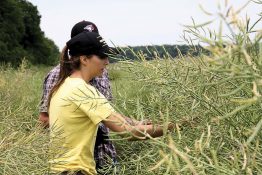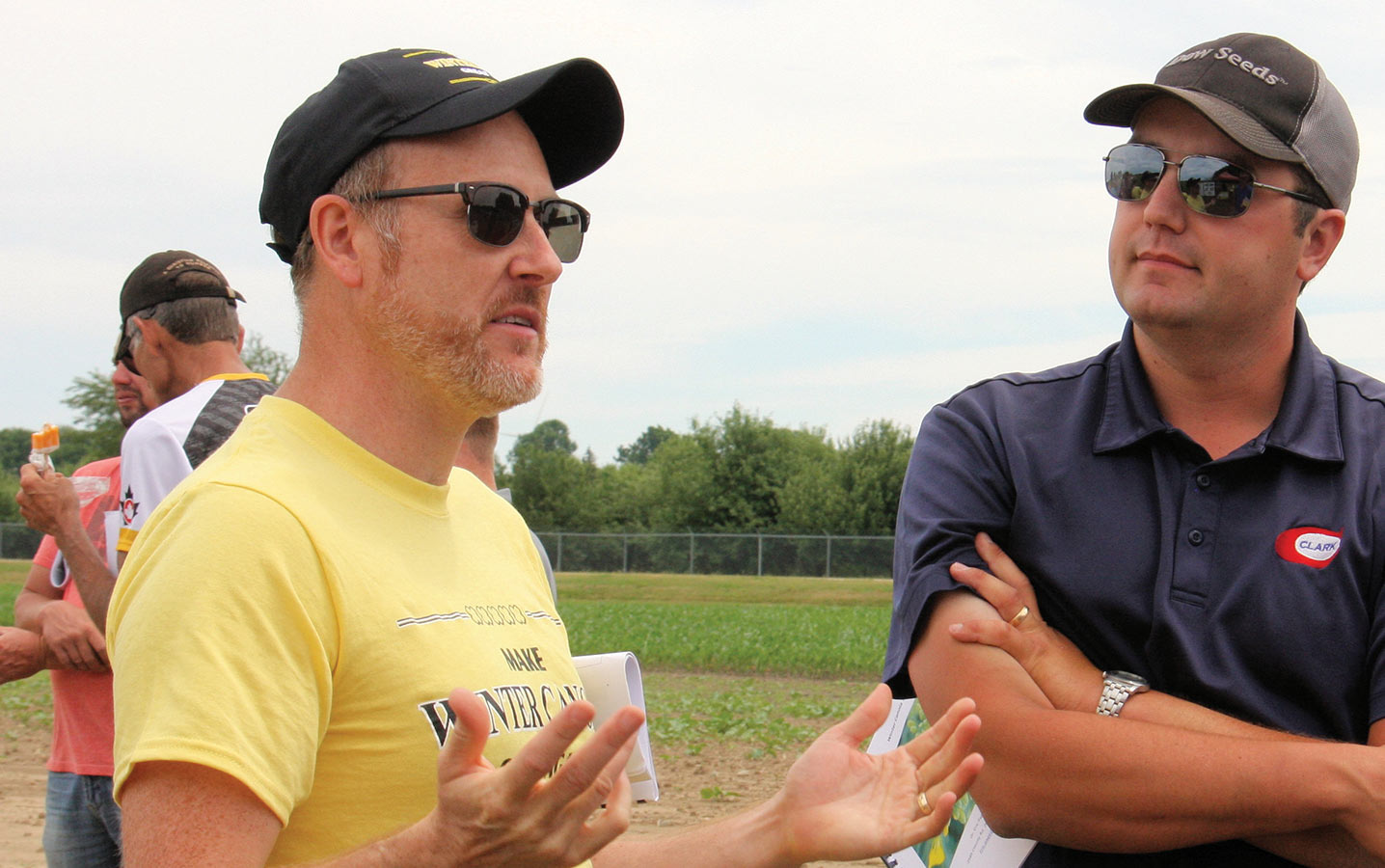Ontario researcher tests double-crop canola and soybeans
Ontario producers are showing a renewed interest in winter canola production as a fit with late-planted soybeans in a double crop. Eric Page, research scientist with Agriculture and Agri-Food Canada (AAFC), leads a planting date trial with winter canola and soybeans to provide these interested producers with some background data.
Winter canola is harvested in July, then Page plants soybeans for harvest in October. Harvesting that late isn’t a problem in his southern area of the province. The rotation would then switch to a different crop the following spring or, if possible, winter wheat planted in early October.
Page hosted a field event June 21 at AAFC Harrow Research and Development Centre in southernmost Ontario to view research plots and discuss the opportunity to double-crop soybeans after winter canola.
Page, a researcher focused on weed ecology, has been studying novel crop rotations as a way to manage hard-to-control weeds. Producers in southern Ontario tend to have short crop rotations and rely heavily on glyphosate-tolerant genetics. But glyphosate-resistant Canada fleabane can be found throughout Ontario and populations of glyphosate-resistant common ragweed, giant ragweed and waterhemp are emerging. A competitive canola crop has weed control advantages, and the double-crop system allows producers to manage the fall-emerged cohort of fleabane plants mid-summer, prior to planting the double-crop soybeans.
Ontario is also pushing producers to keep soil covered year round. Tillage is common in Ontario, and cover crops can mitigate soil loss caused by erosion and help maintain soil organic matter. Producers are using red clover, cereal rye and other cover crops to build and protect soil health, but growing a profitable fall-planted crop may be a more desirable solution to keeping soil covered.
Early-maturing winter canola hybrids would be ideal so that producers can plant double-crop soybeans by mid-July.
| Variety | 2016 Planting Date | ||||
|---|---|---|---|---|---|
| 01-Sept | 13-Sept | 22-Sept | 06-Oct | 17-Oct | |
| Stand Loss Over Winter (%) | |||||
| Mercedes | 30 | 34 | 12 | 10 | 47 |
| Inspiration | 36 | 15 | 16 | 22 | 60 |
| CC17070 | 51 | 18 | 13 | 12 | 47 |
| Mean | 39 | 22 | 14 | 15 | 51 |
| Variety | 2017 Planting Date | ||||
|---|---|---|---|---|---|
| 01-Sept | 11-Sept | 26-Sept | 10-Oct | 20-Oct | |
| Stand Loss Over Winter (%) | |||||
| Mercedes | 8 | 11 | 32 | 100 | 100 |
| Inspiration | 5 | 11 | 23 | 66 | 100 |
| CC17070 | 21 | 28 | 12 | 87 | 98 |
| Sitro | 13 | 9 | 14 | 82 | 99 |
| Mean | 12 | 15 | 20 | 84 | 99 |
A second try for winter canola

Photo Credit: Carrie James
Many spring canola growers in Ontario have tried winter canola, but winter survival was typically poor. The crop would die during harsh winter months or more often heave out of the ground during frost and thaw cycles in March. Page believes new genetics will improve overwintering results, and also speculates the winter crop should be grown in regions south of where spring canola is typically grown. Essentially all spring canola production in Ontario occurs between the 49th parallel (Cochrane) and Guelph, and attempts at growing spring canola further south results in significant flower and pod abortion during the hot summer months. Winter canola flowers in the cooler month of May.
AAFC’s Eric Page believes new genetics will improve overwintering results, and also speculates the winter crop should be grown in regions south of where spring canola is typically grown.
Page worked with seed dealers in Kentucky to select varieties that would be suitable for Ontario. For the past two seasons he has tested the performance of three U.S. varieties over five planting dates in Harrow. Variety and planting date recommendations will be key in successful production, and his work has already supported the interim registration of the variety Mercedes. Other than Mercedes, which is now carried by C&M Seeds, winter varieties registered in Canada are older genetics that are almost impossible for growers to source.
Planting date will likely have to be studied across the southern growing regions, but trials at Harrow indicate early to mid-September planting results in the lowest levels of overwintering losses. (See the table.) Early-maturing winter canola hybrids would be ideal so that producers can plant double-crop soybeans by mid-July.
One winter canola grower had success in 2016 with double-crop soybeans planted at the end of July, but was unable to plant soybeans in 2017 after a late winter-canola harvest. This year Page and producers are on track to harvest their winter canola in early July.
Research is ongoing to verify appropriate planting dates and gather more data on U.S. varieties. Fortunately, the early timing of winter canola bolting means it will not be at risk of swede midge damage, which has significantly hindered spring canola production in Ontario. Further studies on crop rotations, fertility, tillage and slug damage in the fall are also necessary to improve success with winter canola production in Ontario.





